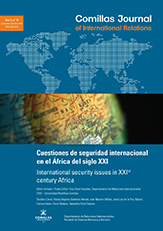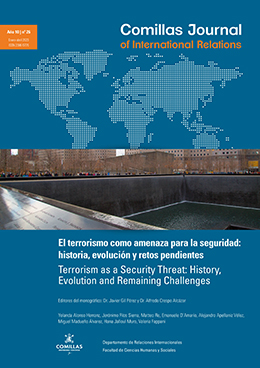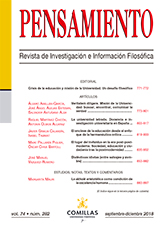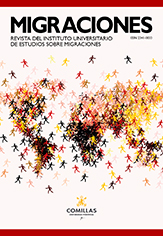Portal de revistas digitales de la Universidad Pontificia Comillas ICAI-ICADE.
Revistas
-
Revista Iberoamericana de Bioética
 Revista Iberoamericana de Bioética es una revista científica de periodicidad cuatrimestral editada como un Open Access Journal por la Universidad Pontificia Comillas junto con otros once centros universitarios de ámbito iberoamericano. La Revista sigue normas estrictas en su proceso editorial que garantizan la excelencia y la relevancia de los textos en ella publicados.
Revista Iberoamericana de Bioética es una revista científica de periodicidad cuatrimestral editada como un Open Access Journal por la Universidad Pontificia Comillas junto con otros once centros universitarios de ámbito iberoamericano. La Revista sigue normas estrictas en su proceso editorial que garantizan la excelencia y la relevancia de los textos en ella publicados.Revista Iberoamericana de Bioética busca, con rigor académico, prestar un servicio de información y formación al mundo de la bioética iberoamericana. Quiere ser también una herramienta eficaz para la formación integral de los alumnos en bioética en diversos cursos, seminarios, másteres y programas de doctorado.
Pretendemos ser una referencia, y ver ello reconocido con la inclusión de la revista en los índices y bases de datos más prestigiosos; pero sobre todo pretendemos ser realmente útiles a la comunidad iberoamericana de estudiantes y profesores de bioética, a los profesionales de la salud y demás especialistas preocupados por la bioética.
-
Comillas Journal of International Relations
 Comillas Journal of International Relations es una revista científica de periodicidad semestral editada como un Open Access Journal por el Departamento de Relaciones Internacionales (Facultad de Ciencias Humanas y Sociales) de la Universidad Pontificia Comillas. En su proceso editorial, la revista sigue normas estrictas que aseguran la excelencia y la relevancia de los textos en ella publicados, garantizando una revisión rigurosa de los envíos mediante sistema de pares ciegos.
Comillas Journal of International Relations es una revista científica de periodicidad semestral editada como un Open Access Journal por el Departamento de Relaciones Internacionales (Facultad de Ciencias Humanas y Sociales) de la Universidad Pontificia Comillas. En su proceso editorial, la revista sigue normas estrictas que aseguran la excelencia y la relevancia de los textos en ella publicados, garantizando una revisión rigurosa de los envíos mediante sistema de pares ciegos.Comillas Journal of International Relations busca ser una publicación que, desde un enfoque científico y académico, preste un servicio al conjunto de una sociedad internacional cada vez más caracterizada por tendencias contradictorias: por un lado, hacia una mayor integración, globalización e interdependencia y, por el otro, hacia crecientes tensiones entre actores deseosos de conseguir una mayor independencia y autonomía estratégica. Tales tendencias requieren un estudio profundo y riguroso, capaz de identificar sus principales causas y consecuencias, y de plantear soluciones a los problemas y crisis que puedan generar.
-
Padres y Maestros / Journal of Parents and Teachers
Padres y Maestros, fundada en 1965, es una publicación trimestral dedicada al tratamiento de temas relacionados con la educación de temática variada. Las páginas de esta revista tratan de acercar a sus lectores a la realidad educativa actual a través de sugerencias, información, dinamismo y actividades. Gracias al amplio espectro de áreas de conocimiento, cada uno de nuestros números de la revista se especializa en una tendencia educativa diferente proporcionando al lector una base informativa multidisciplinar. Nuestros objetivos prioritarios son informar tanto a expertos en la educación (profesores, departamentos educativos, escuelas, etc.) como a gente interesada en la materia (familias, padres, estudiantes, etc.) y animarles a aprender más acerca de este campo.
-
Razón y fe
Razón y Fe fue fundada en 1901 por la Compañía de Jesús. Es la revista de cultura más antigua de España, así como una de las más antiguas en lengua castellana. Se ha publicado ininterrumpidamente desde entonces, incluyendo los periodos de la expulsión de la Compañía de Jesús y de la Guerra Civil española. Desde su fundación ha tratado de concordar los dos elementos que componen su título, facilitando el diálogo entre la fe cristiana y las diferentes racionalidades que se manifiestan en la cultura.
En 2018 Razón y Fe se incorporó a la Cátedra Hana y Francisco José Ayala de Ciencia, Tecnología y Religión (Cátedra CTR) de la Universidad Pontificia Comillas, y desde 2023 se transformó en una revista académica.
De periodicidad semestral, es una revista científica cuyo objetivo es el diálogo interdisciplinar entre las diversas ciencias —naturales, sociales y humanas— y la reflexión filosófica y teológica.
-
Pensamiento. Revista de Investigación e Información Filosófica
Pensamiento es una revista orientada fundacionalmente a la publicación de todo aquello que tenga ampliamente una relación con la filosofía. Pero no es una revista culturalista, de actualidad o miscelánea, sino orientada a la publicación de artículos científicos de investigación, normalmente producidos en ámbitos académicos universitarios, pero no sólo. Sus artículos, notas, comentarios bibliográficos o crónicas, hacen siempre relación a un enfoque serio, riguroso, científico, académico, de la filosofía. Sus autores y colaboradores han surgido en parte de aquellas instituciones de la Compañía de Jesús que la sustentan y editan, pero no sólo, ya que desde sus primeros años de existencia Pensamiento ha estado abierta a todos y ha sido vehículo de expresión donde han publicado sus artículos importantes filósofos y profesores universitarios, tanto de España como de América Latina preferentemente. Pensamiento, en la actualidad, sigue abierta a la publicación de cuantos productos de calidad le sean ofrecidos. Pensamiento edita tres números al año de carácter ordinario. Desde 2007 viene publicando un volumen especial dentro de la serie: Ciencia, Filosofía y Religión.
Pensamiento consta, entre otros, en los siguientes índices y bases de datos internacionales y nacionales: Colección principal de la Web of Science (Clarivate Analytics): Arts & Humanities Citation Index. SCOPUS (Elsevier). Current Contents Connect (WoS). PERIODICAL INDEX ONLINE (ProQuest). INTERNATIONALE BIBLIOGRAPHIE DER GEISTES IBZ. REPERTOIRE BIBLIOGRAPHIQUE DE LA PHILOSOPHIE DE LOUVAIN. PHILOSOPHER'S INDEX (The Philosopher`s center). CBUC (Consorci de Biblioteques Universitàries de Catalunya). InDICEs CSIC. DIALNET (repositorio). LATINDEX. ULRICH`S (ProQuest). MIAR (Sistema de medición cuantitativa de la visibilidad de las publicaciones periódicas en Ciencias Sociales: índice de difusión ICDS de PENSAMIENTO: 9.977). REDIB, Red Iberoamericana de Innovación y Conocimiento Científico.
-
Migraciones. Publicación del Instituto Universitario de Estudios sobre Migraciones
Migraciones es una revista académica interdisciplinaria editada por el Instituto Universitario de Estudios sobre Migraciones (IUEM) de la Universidad Pontificia Comillas.
Su objetivo es publicar en acceso abierto, tanto en castellano como en inglés, investigaciones de calidad que ahonden en el campo de estudio de la movilidad humana priorizando aquellas que aborden cuestiones críticas y de actualidad aplicando las metodologías más avanzadas.
Su periodicidad es semestral, apareciendo dos números por año (diciembre y junio). El número 0 se publicó en diciembre de 1996.
La Revista Migraciones sigue un sistema de publicación de acceso abierto, por el cual tanto la publicación como la lectura de los trabajos están exentos de tasas. Todo el contenido publicado está completamente disponible para su consulta y descarga de manera gratuita e inmediata en la página web de la revista.
Migraciones está indexada en Scopus , Latindex, InDICEs CSIC, Emerging Sources Citation Index y otros.
Primera decisión en 3 días Tasa de aceptación del 18,6% 103.092 visualizaciones de artículos (2024)
-
Estudios Eclesiásticos. Revista de investigación e información teológica y canónica
Estudios Eclesiásticos fue fundada en 1922 por la Compañía de Jesús como órgano de las facultades de Teología de la Compañía en España.
De periodicidad trimestral, es una revista científica cuyo objetivo es la difusión de la investigación en el ámbito de la Teología y el Derecho Canónico editada por la Facultad de Teología de la Universidad Pontificia Comillas.
Los contenidos de Estudios Eclesiásticos se encuentran indizados en las siguientes bases de datos: Scopus, IBZ Online, PASCAL, desde 1993 en la base de datos FRANCIS del INIST-CNRS, L'Année philologique, Old Testament Abstracts Online, Atla Religion Database, DIALOG Information Services, desde 1984 en la publicación bibliográfica Religion index one: Periodicals (RIO) ISSN 0149-8428, de la American Theological Library Association de Chicago (USA), Index Theologicus desde el número 52 (1977), Latindex (catálogo), DOAJ, REDIB y DIALNET.
Los artículos de Estudios Eclesiásticos se hallan digitalizados y pueden descargarse, bajo suscripción, y con un retraso aproximadamente de un año, en AtlaSerials. Las suscripciones se gestionan a través de la base de datos EBSCO.
RIO está también informatizado en el banco de datos Atla Religion Database y es accesible a través de BRS (Bibliographic Retrieval Services), Latham, New York, y DIALOG Information Services, Palo Alto, California.
-
ICADE. Revista de la Facultad de Derecho
Revista icade es una de las revistas propias de la Universidad Pontificia Comillas que tiene el subtítulo de “Revista de la Facultad de Derecho”, como expresión de su especial vinculación al centro mencionado.
Se publicó por primera vez en el año 1984 como una revista multidisciplinar destinada a abarcar los principales aspectos relacionados con el ámbito del Derecho, la Economía y la Administración y Dirección de Empresas. Es una publicación científica, de periodicidad semestral, en la que se exigen los criterios de calidad propios de este tipo de publicaciones pero que, además, siempre ha pretendido exponer, analizar y dar respuestas y propuestas a los importantes cambios que se han ido produciendo a lo largo de los años en las áreas de conocimiento propias de la esfera jurídica, económica y empresarial. Desde el año 2020 la Revista icade se centra en la innovación y los cambios jurídicos que se producen o se deben producir en un mundo caracterizado por las transformaciones constantes en todos los aspectos de la vida social.
Desde el número 106, la Revista icade se publica en acceso abierto. Sus contenidos están disponibles en esta misma web desde el número 61.
En diciembre de 2021, la Revista icade editó su último número, dedicado a los procesos constituyentes.
-
Miscelánea Comillas. Revista de Ciencias Humanas y Sociales
Miscelánea Comillas es una revista semestral de investigación e información en ciencias sociales: humanidades, psicología, educación, sociología y trabajo social.
La revista consta en los siguientes índices y bases de datos nacionales e internacionales:
PERIODICAL INDEX ONLINE (ProQuest) Base de datos de citas de artículos que se han publicado en las Artes, Humanidades y Ciencias Sociales. ATLA Religión Database. INTERNATIONALE BIBLIOGRAPHIE DER GEISTES IBZ. Base de datos de publicaciones periódicas de Humanidades y Ciencias Sociales. MLA (Modern Language Association database). InDICEs CSIC, Base de datos bibliográfica de la producción científica publicada en España. DIALNET (Repositorio). LATINDEX, sistema de información para revistas científicas de América Latina, España, el Caribe y Portugal. ULRICH'S (ProQuest). MIAR (Sistema de medición cuantitativa de la visibilidad de las publicaciones periódicas en Ciencias Sociales: índice de difusión ICDS de MISCELÁNEA COMILLAS: 6.5). REDIB, Red Iberoamericana de Innovación y Conocimiento Científico. DOAJ, Directory of Open Access Journals.















